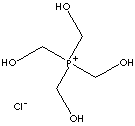|
Phosphonium describes a univalent radical, PH4,
phosphorus
analogous to ammonium.
Quaternary phosphonium salts, obtained from tertiary
alkylphosphines with the treatment with alkyl or aromatic halides, are replacing
phase transfer catalysts and biocides functions for quaternary ammonium salts
due to more effective performance and higher thermal stability. Phosphonium
saltds are used as flame retardants in textile, especially cotton,
and as cease and rot
resistance agents in fabric. They acts as biocides
against SRB (Sulphate reducing bacteria known as
Desulfuvibrio Desulfuricans) which produce enzymes to accelerate the reduction
reaction of sulphates to the corrosive hydrogen sulphide and causes corrosion of
iron material in a water system. Phosphonium
salts are used as epoxy curing agents. A variety of phosphine transition metal
complexes including chiral complexes are synthesized as the very reactive and
versatile homogeneous catalysts and stereospecific as well.
Tetrakis(hydroxymethyl)phosphonium Chloride
is used as a flame retardant in textiles. THPC
acts as a biocide against SRB
(Sulphate reducing bacteria known as Desulfuvibrio Desulfuricans)
which produce enzymes to accelerate the reduction reaction
of sulphates to the corrosive hydrogen sulphide and
causes corrosion of iron material in a water system.
When THPC acts as a corrosion
inhibitor in circulating water system. It has been replaced by the sulfate compound because of its
forming of carcinogenic compound.
|
